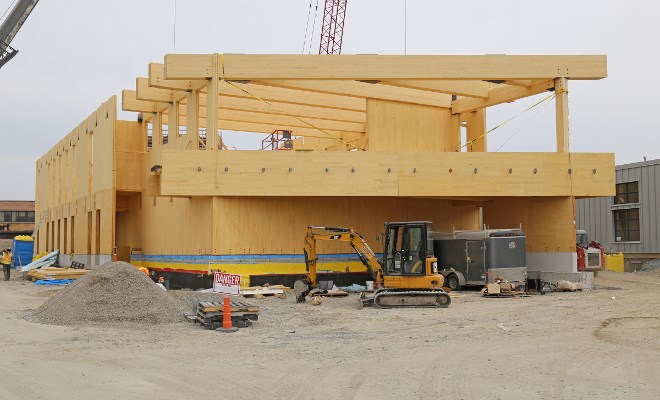Recently announced funding for Ontario’s Mass Timber Program will lay the foundational blocks for innovative, new building techniques using wood, according to Ontario Wood WORKS!, the provincial voice of wood construction advocacy.
Marianne Berube, the organization’s executive director, noted that, while Natural Resources Canada has dallied in grants for mass timber developments, this is the first time the province has offered assistance for mass timber demonstration projects.
“It’s something new,” she said. “It’s innovation; it’s pushing the limits, and that’s what this funding’s for.”
On April 25, the province announced it would put $7.8 million toward the previously announced program, which is designed to support research, education and construction projects related to tall wood buildings.
Of those funds, $3.15 million will go into the research and development of mass timber building systems, while another $2.2 million will go into development and training for architects, engineers, designers, builders, educators and trades workers.
The final $2.45 million will be used to offset the cost of four mass timber building projects: George Brown College’s 12-storey Arbour development in Toronto; the 14-storey Academic Tower at the University of Toronto; a 12-storey residential condominium building to be developed by Green-vision Developments in North Bay; and the 57 Wade Avenue development, an eight-storey office building to be built in Toronto.
The current Ontario Building Code allows for the construction of wood-frame buildings up to six storeys. Mass timber construction uses engineered wood products like cross-laminated timber and glue-laminated timber to construct larger, stronger structures.
“This is a different way of building,” Berube said. “It’s been going on in Europe for years, but coming to Canada, it’s really just taking off.”
A smattering of mass timber buildings do exist in Canada. The University of British Columbia completed its 18-storey Brock Commons student residence in July,
2017, and in Québec City construction is ongoing on Origine, a 13-storey condominium development that, when complete, will be the tallest wood construction condominium in North America.
The benefits of mass timber construction are numerous. Its carbon sequestration qualities are prized for combating climate change, and because it’s lighter, it’s easier to transport, handle and build with.
There’s also an expectation that, if mass timber construction takes off, an increased number of wood developments will result in demand for more mills and the creation of more jobs.
“Right now, there’s one mill that’s just about ready to open, producing mass timber, and a few others are looking into it,” Berube said. “So it creates the secondary manufacturing.”
Ontario currently hosts 42 per cent of the country’s construction market, she noted, and so there’s big potential for demand to grow in southern Ontario where development is booming.
All four of the demonstration projects are in the very early stages of development. Planning for the University of Toronto’s Academic Tower seems to be the most advanced, with a construction start time slated for the end of 2019.
In order for each project to go forward, special zoning approvals need to be put in place, and those approvals only apply to that specific project, Berube said. For mass timber construction to be adopted on a wider scale, changes to the national building code are required.
A similar scenario played out leading up to the adoption of six-storey wood-frame construction, which required research and demonstration projects to come online before the industry was fully accepting of it.
The Ontario Building Code was finally amended to allow construction of wood-frame buildings up to six storeys in 2015, and a bill is currently being reviewed that would increase that number to 14 storeys.
Now, the popularity of wood-frame construction has risen to the point that Wood WORKS! is tracking the progress of 125 projects across Ontario.
“Right now it’s a real renaissance for wood,” Berube said. “There are so many things coming together; it’s really picking up now.”
The next cycle of building code changes is scheduled to take effect in 2020, and, if approved, they’ll allow for mass timber construction up to 12 storeys, Berube said.
Meanwhile, government funding will go a long way to further the industry’s understanding of mass timber construction and the benefits it can bring.
“We really laud the Ontario government for the support,” Berube said. “It’s time for Ontario to show that we can do this, too, and be a leader.”




